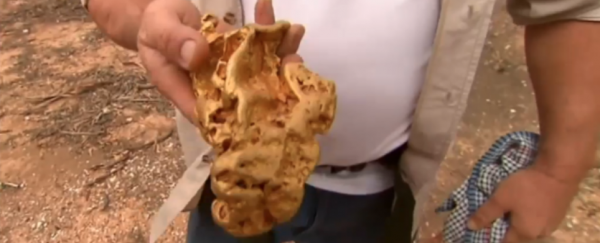Mick Brown from the rural town of Kerang in northern Victoria struck literal gold this week when his wife told him to go outside and get some air, because his bad mood was bringing everyone down. Having recently quit smoking, Brown took his frustrations and metal detector out into the bush surrounding the neighbouring town of Wedderburn, and pretty soon picked up a huge signal.
Just 15 centimetres under the soil sat a 2.7 kilogram nugget of solid gold, which Brown told 9News is valued at around $135,000. He's not parting with it for less than $200,000 though, saying that the beauty of the specimen might just convince a collector to pay that much.
As jealous as we can be about the find, it's not like this is the first time Brown took his metal detector out of a stroll. He's a seasoned prospector, and knows the signs of something special when he hears them. "It's a hobby, not just a hobby, it's a skill to read the ground, to distinguish targets and to listen," he told 9News.
It's hard to believe, after all the time, effort, and billions of dollars we humans put into extracting everything of value out of the planet, it's still holding onto a few precious morsels. And when it comes to gold, we still don't really know how much is left on Earth.
Investor Warren Buffett famously said that the total amount of gold left in the world - that we've mined, anyway - could fit inside a cube with sides measuring just 20 metres. And in 2013, Ed Prior from BBC News reported that this is actually pretty accurate, with the GFMS team at Thomson Reuters estimating that there's 171,300 tonnes in circulation, which would fit very nicely into Buffett's imaginary box. But this figure is up for serious debate. "Estimates range from 155,244 tonnes, marginally less than the GFMS figure, to about 16 times that amount - 2.5 million tonnes," says Prior.
And that's just the gold we've already dug up. According to the BBC, the US Geological Survey estimates there are 52,000 tonnes of mineable gold still hidden in the ground, and that's a conservative estimate. Which sounds like a lot, until you think about how it's being used. "All the gold that has been mined throughout history is still in existence in the above-ground stock," James Turk, the founder of the Gold Money Foundation, which conducts reports on the value and availability of precious metals, told Prior. "That means that if you have a gold watch, some of the gold in that watch could have been mined by the Romans 2,000 years ago."
But the way we're currently using gold is getting more and more wasteful, because we're using it in amounts too small to recycle. For example, if you collect 41 smartphones, you've got about 1 gram of gold. When you think about how many smartphones are being produced and thrown out around the world every year, that's a whole lot of gold that will never go back into circulation. One day, we might actually run out of gold altogether, and suddenly $135k seems like a real bargain for that nice big Australian chunk of the stuff.
